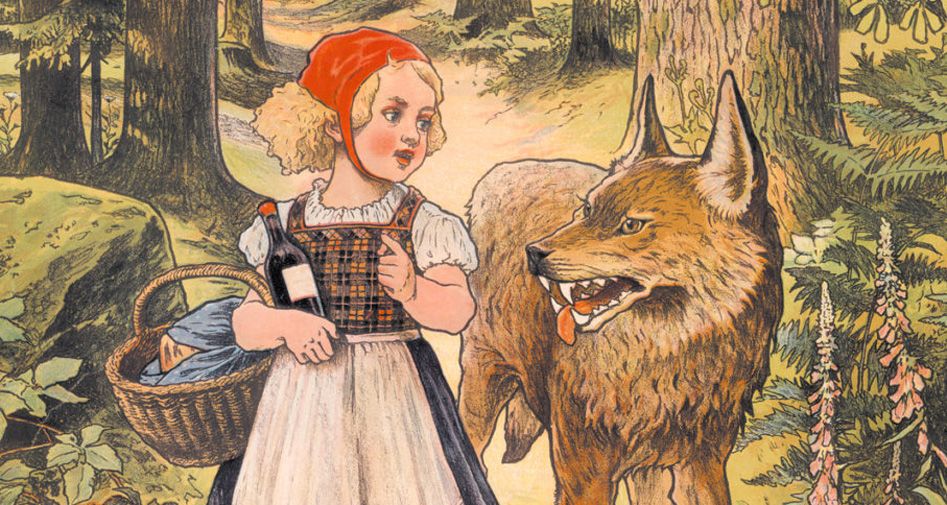Reading time for children: 10 min
Once upon a time there was a sweet little girl. Everyone who saw her liked her, but most of all her grandmother, who did not know what to give the child next. Once she gave her a little cap made of red velvet. Because it suited her so well, and she wanted to wear it all the time, she came to be known as Little Red Riding Hood. One day her mother said to her: „Come Little Red Riding Hood. Here is a piece of cake and a bottle of wine. Take them to your grandmother. She is sick and weak, and they will do her well.
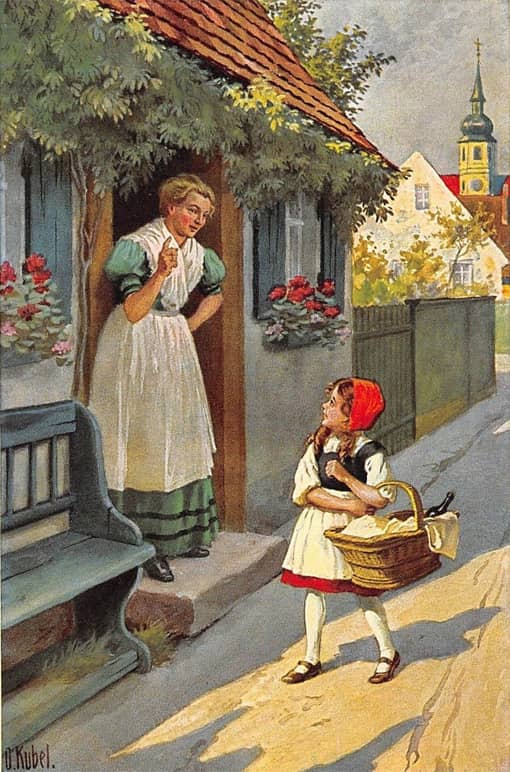 Image: Otto Kubel (1868 – 1951)
Image: Otto Kubel (1868 – 1951)Mind your manners and give her my greetings. Behave yourself on the way, and do not leave the path, or you might fall down and break the glass, and then there will be nothing for your sick grandmother.“ Little Red Riding Hood promised to obey her mother. The grandmother lived out in the woods, a half hour from the village. When Little Red Riding Hood entered the woods a wolf came up to her. She did not know what a wicked animal he was, and was not afraid of him. „Good day to you, Little Red Riding Hood.“ – „Thank you, wolf.“ – „Where are you going so early, Little Red Riding Hood?“ – „To grandmother’s.“
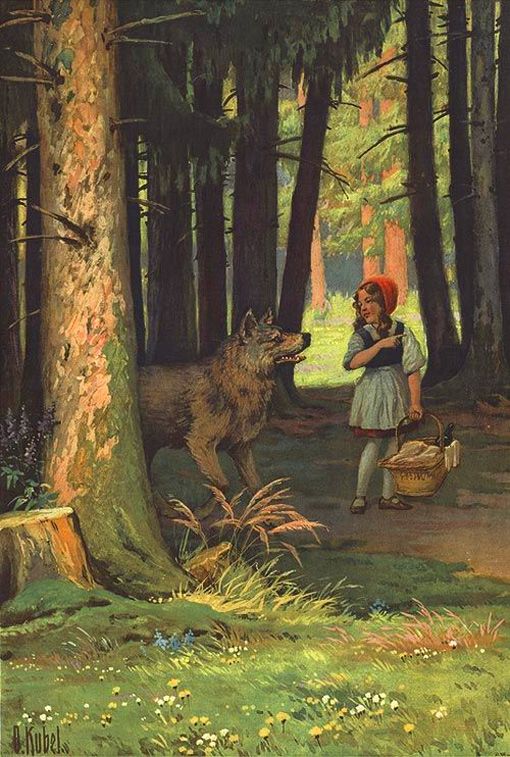 Image: Otto Kubel (1868 – 1951)
Image: Otto Kubel (1868 – 1951)„And what are you carrying under your apron?“ – „Grandmother is sick and weak, and I am taking her some cake and wine. We baked yesterday, and they should give her strength.“ – „Little Red Riding Hood, just where does your grandmother live?“ – „Her house is a good quarter hour from here in the woods, under the three large oak trees. There’s a hedge of hazel bushes there. You must know the place,“ said Little Red Riding Hood. The wolf thought to himself: „Now there is a tasty bite for me. Just how are you going to catch her?“
Then he said: „Listen, Little Red Riding Hood, haven’t you seen the beautiful flowers that are blossoming in the woods? Why don’t you go and take a look? And I don’t believe you can hear how beautifully the birds are singing. You are walking along as though you were on your way to school in the village. It is very beautiful in the woods.“ Little Red Riding Hood opened her eyes and saw the sunlight breaking through the trees and how the ground was covered with beautiful flowers. She thought: „If a take a bouquet to grandmother, she will be very pleased. Anyway, it is still early, and I’ll be home on time.“ And she ran off into the woods looking for flowers. Each time she picked one she thought that she could see an even more beautiful one a little way off, and she ran after it, going further and further into the woods.
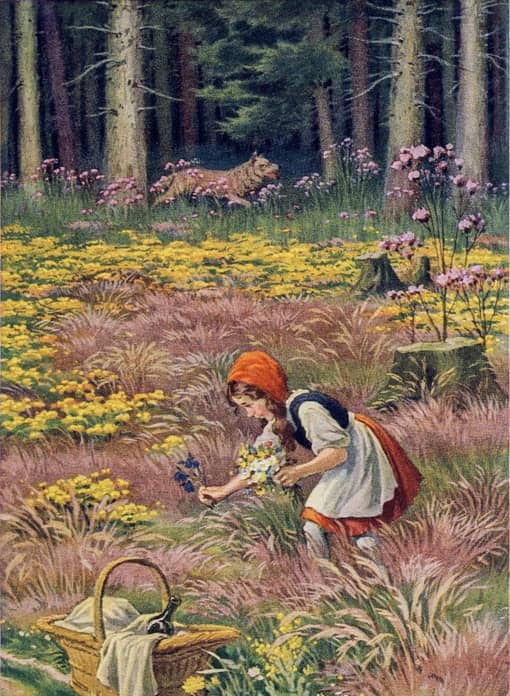 Image: Otto Kubel (1868 – 1951)
Image: Otto Kubel (1868 – 1951)But the wolf ran straight to the grandmother’s house and knocked on the door. „Who’s there?“ – „Little Red Riding Hood. I’m bringing you some cake and wine. Open the door for me.“ – „Just press the latch,“ called out the grandmother. „I’m too weak to get up.“ The wolf pressed the latch, and the door opened. He stepped inside, went straight to the grandmother’s bed, and ate her up. Then he took her clothes, put them on, and put her cap on his head.
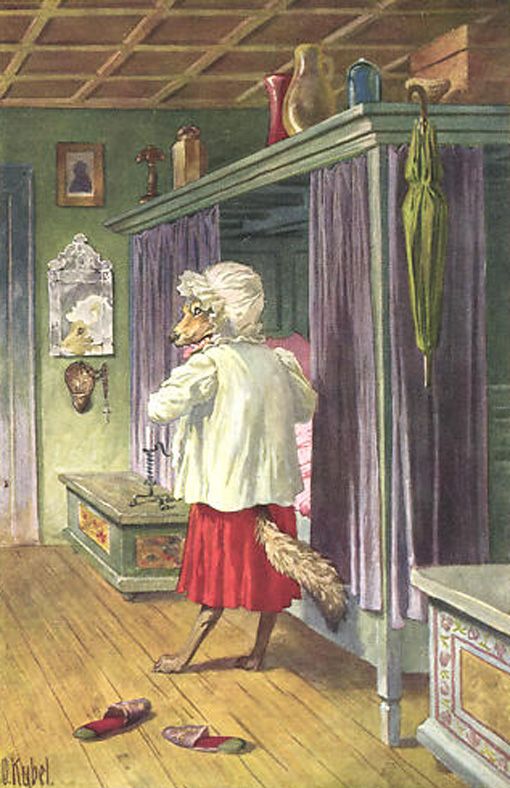 Image: Otto Kubel (1868 – 1951)
Image: Otto Kubel (1868 – 1951)He got into her bed and pulled the curtains shut. Little Red Riding Hood had run after flowers, and did not continue on her way to grandmother’s until she had gathered all that she could carry. When she arrived, she found, to her surprise, that the door was open. She walked into the parlor, and everything looked so strange that she thought: „Oh, my God, why am I so afraid? I usually like it at grandmother’s.“ Then she went to the bed and pulled back the curtains.
Grandmother was lying there with her cap pulled down over her face and looking very strange. „Oh, grandmother, what big ears you have!“ – „All the better to hear you with.“ – „Oh, grandmother, what big eyes you have!“ – „All the better to see you with.“ – „Oh, grandmother, what big hands you have!“ – „All the better to grab you with!“ – „Oh, grandmother, what a horribly big mouth you have!“ – „All the better to eat you with!“ And with that he jumped out of bed, jumped on top of poor Little Red Riding Hood, and ate her up.
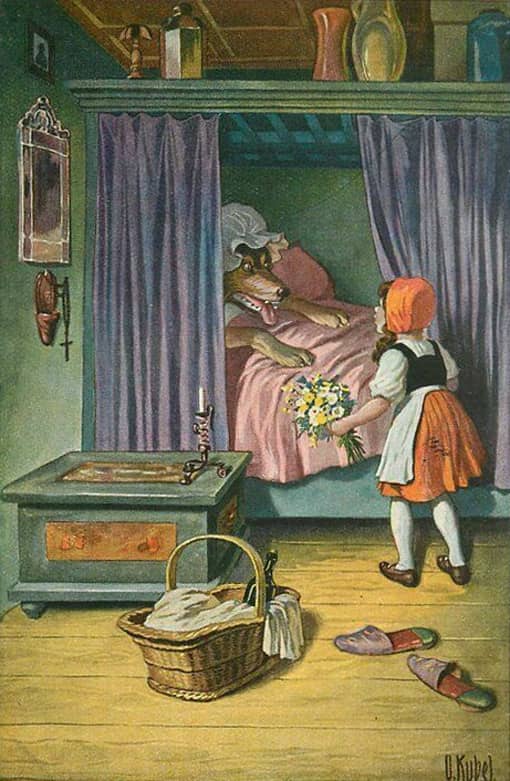 Image: Otto Kubel (1868 – 1951)
Image: Otto Kubel (1868 – 1951)As soon as the wolf had finished this tasty bite, he climbed back into bed, fell asleep, and began to snore very loudly. A huntsman was just passing by. He thought it strange that the old woman was snoring so loudly, so he decided to take a look. He stepped inside, and in the bed there lay the wolf that he had been hunting for such a long time. „He has eaten the grandmother, but perhaps she still can be saved. I won’t shoot him,“ thought the huntsman. So he took a pair of scissors and cut open his belly. He had cut only a few strokes when he saw the red cap shining through.
He cut a little more, and the girl jumped out and cried: „Oh, I was so frightened! It was so dark inside the wolf’s body!“ And then the grandmother came out alive as well. Then Little Red Riding Hood fetched some large heavy stones. They filled the wolf’s body with them, and when he woke up and tried to run away, the stones were so heavy that he fell down dead. The three of them were happy. The huntsman took the wolf’s pelt. The grandmother ate the cake and drank the wine that Little Red Riding Hood had brought. And Little Red Riding Hood thought to herself: „As long as I live, I will never leave the path and run off into the woods by myself if mother tells me not to.“
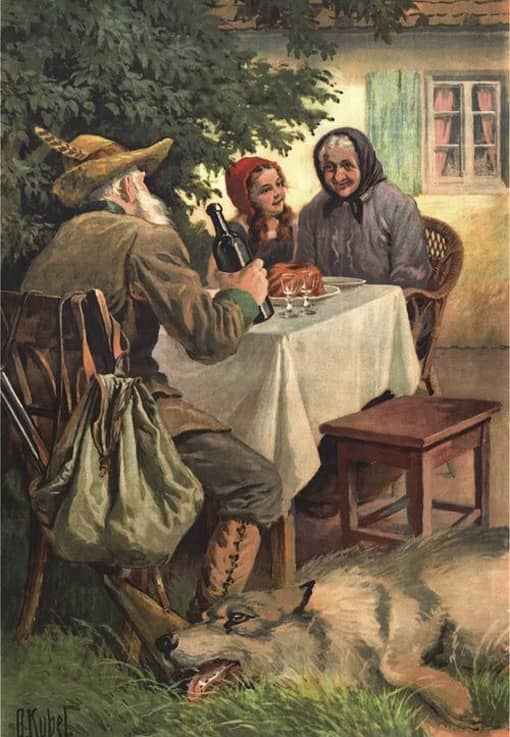 Image: Otto Kubel (1868 – 1951)
Image: Otto Kubel (1868 – 1951)They also tell how Little Red Riding Hood was taking some baked things to her grandmother another time, when another wolf spoke to her and wanted her to leave the path. But Little Red Riding Hood took care and went straight to grandmother’s. She told her that she had seen the wolf, and that he had wished her a good day, but had stared at her in a wicked manner. „If we hadn’t been on a public road, he would have eaten me up,“ she said. „Come,“ said the grandmother. „Let’s lock the door, so he can’t get in.“
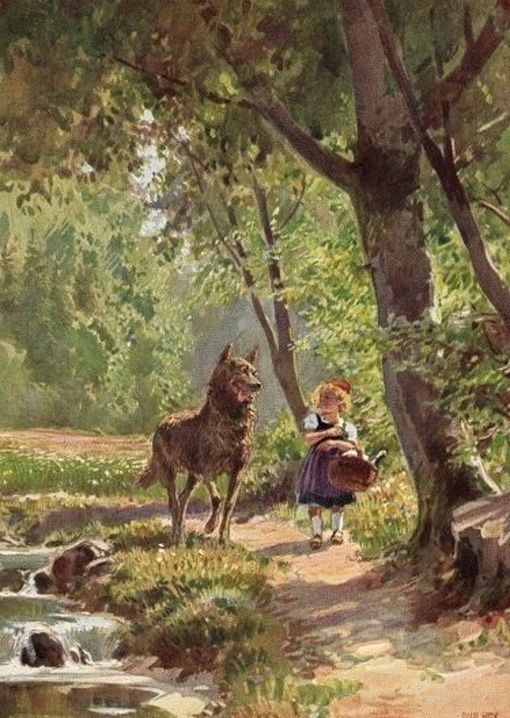 Image: Paul Hey (1867 – 1952)
Image: Paul Hey (1867 – 1952)Soon afterward the wolf knocked on the door and called out: „Open up, grandmother. It’s Little Red Riding Hood, and I’m bringing you some baked things.“ They remained silent, and did not open the door. The wicked one walked around the house several times, and finally jumped onto the roof. He wanted to wait until Little Red Riding Hood went home that evening, then follow her and eat her up in the darkness. But the grandmother saw what he was up to.
There was a large stone trough in front of the house. „Fetch a bucket, Little Red Riding Hood,“ she said. „Yesterday I cooked some sausage. Carry the water that I boiled them with to the trough.“ Little Red Riding Hood carried water until the large, large trough was clear full. The smell of sausage arose into the wolf’s nose. He sniffed and looked down, stretching his neck so long that he could no longer hold himself, and he began to slide. He slid off the roof, fell into the trough, and drowned. And Little Red Riding Hood returned home happily and safely.
 Learn languages. Double-tap on a word.Learn languages in context with Childstories.org and Deepl.com.
Learn languages. Double-tap on a word.Learn languages in context with Childstories.org and Deepl.com.Backgrounds to fairy tale „Little Red Riding Hood“
„Little Red Riding Hood,“ also known as „Little Red Cap“ or „Rotkäppchen“ in German, is a well-known European fairy tale that has been passed down through generations in oral storytelling traditions. The Brothers Grimm included the story in their collection „Grimm’s Fairy Tales“ (originally titled „Children’s and Household Tales“ or „Kinder- und Hausmärchen“ in German), which was first published in 1812.
The tale is classified as ATU 333 (Little Red Riding Hood) in the Aarne-Thompson-Uther classification system, which categorizes folktales based on their narrative structure and elements. The story has its roots in older European folktales, and various versions of the tale have been recorded across Europe, with each version differing in details and endings.
The Brothers Grimm, Jacob and Wilhelm, were German academics, linguists, and cultural researchers who collected and published numerous folk and fairy tales during the 19th century. Their goal was to preserve the cultural heritage and oral storytelling traditions of German-speaking regions. The tales they collected were often based on stories passed down through generations and have roots in older myths and legends.
„Little Red Riding Hood“ tells the story of a young girl, dressed in a red cape, who is sent by her mother to deliver food to her sick grandmother. On her way through the woods, she encounters a cunning wolf, who tricks her into revealing her destination. The wolf races ahead, devours the grandmother, and disguises himself in her clothing. When Little Red Riding Hood arrives, she is deceived by the wolf and ultimately eaten as well. In the Brothers Grimm version, a huntsman arrives in time to save both Little Red Riding Hood and her grandmother by cutting open the sleeping wolf’s belly.
The tale has been interpreted and analyzed from various perspectives, including psychoanalytic, feminist, and moralistic viewpoints. Its themes of innocence, danger, deception, and resourcefulness have made it a popular subject for study in literature and folklore. „Little Red Riding Hood“ has also been adapted into numerous forms of media, including theater, ballet, opera, film, and television. These adaptations have varied in tone and content, ranging from faithful retellings of the original story to modern, subversive interpretations that challenge traditional themes and gender roles.
The tale has been interpreted as a warning to young children about the dangers of talking to strangers and venturing too far from the safety of home. The story also explores themes of innocence, deception, and resourcefulness, with Little Red Riding Hood serving as a symbol of youthful naivety that must be tempered by experience and caution. The enduring popularity of „Little Red Riding Hood“ can be attributed to its universal appeal, engaging narrative, and memorable characters. It continues to be a beloved story that has captured the imaginations of generations and remains an important part of global folklore and literature.
Interpretations to fairy tale „Little Red Riding Hood“
„Little Red Riding Hood“ has been subject to various interpretations over time, demonstrating the depth and complexity of Grimm fairy tales. Some key interpretations of the story include:
Loss of innocence: Little Red Riding Hood represents innocence and naivety, as she is easily deceived by the cunning wolf. The story can be interpreted as a coming-of-age tale, where the protagonist must learn from her mistakes and gain wisdom through experience.
Civilization and nature: The tale juxtaposes the safety of Little Red Riding Hood’s home and village (symbols of civilization) with the dangers of the forest (a symbol of nature’s wild, untamed side). The story emphasizes the importance of staying within the boundaries of one’s familiar, safe environment and being cautious when venturing into the unknown.
Gender roles and expectations: In some interpretations, the story has been analyzed as a reflection of societal expectations for women, particularly in the context of the 19th century. Little Red Riding Hood’s vulnerability and innocence can be seen as a representation of the societal expectation for women to be naive and dependent on male figures, such as the huntsman who ultimately saves her. The tale has been criticized for perpetuating traditional gender roles, with Little Red Riding Hood being portrayed as a naive and vulnerable girl who must rely on the protection of a male figure (the huntsman). However, some modern adaptations of the story have sought to challenge these gender stereotypes by presenting Little Red Riding Hood as a more independent and capable character.
Deception and cunning: The wolf in the story serves as an embodiment of cunning and deception, illustrating the danger posed by individuals who use their intelligence and charm to manipulate others. The tale warns against being too trusting and highlights the importance of discernment and critical thinking. The story highlights the importance of being resourceful and quick-thinking in the face of danger. Both the wolf and Little Red Riding Hood demonstrate cunning in their attempts to outsmart each other. The huntsman’s resourcefulness ultimately saves the day, emphasizing the value of intelligence and adaptability in overcoming challenges.
Coming of age: One interpretation sees the story as a metaphor for a young girl’s journey into adulthood. The red cap may symbolize her transition from childhood to womanhood, while the wolf represents the dangers and temptations she may face along the way. The story teaches the importance of obedience and caution, as well as the need to resist straying from the path of righteousness.
Strangers and danger: The tale can be seen as a warning about the potential dangers of interacting with strangers. Little Red Riding Hood’s encounter with the wolf teaches children to be cautious when dealing with unfamiliar people and to listen to the advice of their parents or guardians. The story can be seen as a cautionary tale, warning children about the dangers of talking to strangers and disobeying their parents‘ instructions. Little Red Riding Hood’s encounter with the wolf serves as a reminder that the world can be a dangerous place, and children should be cautious in their interactions with unfamiliar people.
Good versus evil: The story presents a classic battle between good (Little Red Riding Hood and her grandmother) and evil (the wolf). The ultimate victory of good over evil sends a positive message about the triumph of innocence, purity, and righteousness over wickedness and deception.
These various interpretations of „Little Red Riding Hood“ showcase the richness of the story and its ability to convey different meanings and messages to readers. The tale’s themes of innocence, deception, and caution continue to resonate with audiences today, making it one of the most enduring and well-known fairy tales in the Western literary tradition.
The story has evolved over time, with many variations across different cultures. The basic plot, however, remains consistent: a young girl, wearing a red hood or cap, is sent by her mother to visit her grandmother, who lives in the woods. Along the way, she encounters a wolf that ultimately tries to deceive and eat her, but she is saved by a huntsman or another figure. Overall, „Little Red Riding Hood“ offers multiple layers of interpretation, allowing readers to find various meanings and lessons in the story based on their personal perspectives and experiences.
Adaptions of the fairy tale „Little Red Riding Hood“
„Little Red Riding Hood“ is a European fairy tale that has been passed down through oral tradition for centuries. It was first published by Charles Perrault in 1697 under the title „Le Petit Chaperon Rouge“ as part of his collection „Tales of Mother Goose.“ Later, the Brothers Grimm included their own version of the story, called „Rotkäppchen,“ in their collection „Children’s and Household Tales,“ first published in 1812. „Little Red Riding Hood“ has been adapted and reimagined numerous times over the years, demonstrating the enduring appeal and adaptability of the Brothers Grimm’s fairy tales. Some specific examples of these adaptations include:
Literature: „The Company of Wolves“ by Angela Carter: This short story, part of the collection „The Bloody Chamber,“ offers a darker and more feminist retelling of „Little Red Riding Hood,“ exploring themes of sexuality, desire, and the power dynamics between men and women.
Films: „Red Riding Hood“ (2011): Directed by Catherine Hardwicke, this film is a gothic adaptation of the fairy tale, starring Amanda Seyfried as the titular character. The movie adds a romantic subplot and a werewolf mystery, creating a darker and more suspenseful version of the story. „Red Riding Hood“: This 2011 film, directed by Catherine Hardwicke, reimagines „Little Red Riding Hood“ as a supernatural romance, with Amanda Seyfried playing a young woman torn between two potential lovers, one of whom may be a werewolf. „The Company of Wolves“: This 1984 horror film, directed by Neil Jordan, uses „Little Red Riding Hood“ as a starting point for a series of eerie and unsettling tales.
Television: „Grimm“ (2011-2017): This American TV series incorporates elements of various Grimm fairy tales, including „Little Red Riding Hood,“ weaving them into a modern crime drama where the protagonist, a detective, is a descendant of the Grimm family and can see supernatural creatures hidden among humans. „Once Upon a Time“ (2011-2018): The popular TV series reimagines various fairy tale characters, including Red Riding Hood, as they navigate the challenges of living in both the magical and the modern world.
Theater and musicals: „Into the Woods“ (1986): Stephen Sondheim’s musical intertwines the plots of several Brothers Grimm fairy tales, including „Little Red Riding Hood,“ as the characters embark on a quest to fulfill their desires. The production explores themes of wishes, consequences, and the importance of community. Stephen Sondheim’s musical „Into the Woods“ incorporates „Little Red Riding Hood“ and other fairy tales into a single narrative. The musical was adapted into a film in 2014, starring Meryl Streep, Emily Blunt, and Johnny Depp.
Animation: „Hoodwinked!“ (2005): This computer-animated film presents a comedic and modern retelling of „Little Red Riding Hood“ as a crime caper, with various characters offering their perspectives on the events that transpired in the story. This 2005 animated film tells the story of „Little Red Riding Hood“ from the perspectives of various characters, including Little Red herself, the wolf, and a detective investigating the case.
Picture books and illustrations: „Little Red Riding Hood“ by Jerry Pinkney: This Caldecott Honor-winning picture book retells the classic fairy tale with lush illustrations, bringing the story to life for young readers. „Little Red Riding Hood“: This children’s book, written by Trina Schart Hyman, features lush illustrations and a text faithful to the original Grimm fairy tale. „Red“: This young adult novel by Liesl Shurtliff retells the story of „Little Red Riding Hood“ from the perspective of the wolf, who is revealed to be a misunderstood creature with a tragic backstory.
The fairy tale „Little Red Riding Hood“ has been adapted into various forms of media over the years, including books, films, television shows, and stage productions. These adaptations showcase the enduring appeal and versatility of „Little Red Riding Hood.“ The story has been reimagined in various genres, formats, and styles, illustrating the universality and adaptability of the Brothers Grimm’s classic fairy tales. These are just a few examples of the many adaptations of „Little Red Riding Hood“ that have been created over the years. The story’s enduring popularity and timeless themes continue to inspire new interpretations and retellings in a variety of forms.
Summary of the plot
„Little Red Riding Hood“ is a classic fairy tale collected by the Brothers Grimm. The story follows a young girl, known as Little Red Riding Hood, who is given a red hooded cape by her grandmother. One day, her mother asks her to deliver some food to her sick grandmother, who lives in a cottage deep in the woods.
On her way to her grandmother’s house, Little Red Riding Hood encounters a cunning wolf. Unaware of the wolf’s true intentions, she naively reveals her destination to the wolf. The wolf then suggests that she pick some flowers for her grandmother, which distracts Little Red Riding Hood and gives the wolf time to race ahead to the cottage.
Upon reaching the grandmother’s house, the wolf devours the grandmother and disguises himself in her clothing. When Little Red Riding Hood arrives, she is deceived by the wolf’s disguise and engages in a conversation with him, commenting on his big ears, eyes, and teeth. Eventually, the wolf reveals his true self and devours Little Red Riding Hood as well.
In the Brothers Grimm version of the story, a huntsman passing by the cottage hears the wolf’s loud snoring and becomes suspicious. The huntsman enters the house and discovers the sleeping wolf. Suspecting that the wolf has eaten Little Red Riding Hood and her grandmother, the huntsman cuts open the wolf’s belly, freeing them both unharmed. The huntsman then fills the wolf’s stomach with stones, causing the wolf to die when he awakens. The tale serves as a cautionary story, warning children about the dangers of talking to strangers and the importance of following their parents‘ instructions. It also explores themes of innocence, deception, and the contrast between the safety of home and the dangers of the outside world.
Abstract
„Little Red Riding Hood“ is a fairy tale by the Brothers Grimm that tells the story of a young girl who is given a red velvet cap by her grandmother. The cap suits her so well that she becomes known as Little Red Riding Hood. One day, her mother sends her to deliver cake and wine to her sick grandmother, who lives in the woods. Little Red Riding Hood is warned to stay on the path and mind her manners.
In the woods, she meets a wolf who cunningly learns the location of her grandmother’s house. Distracted by the beautiful flowers, Little Red Riding Hood wanders off the path. Meanwhile, the wolf reaches the grandmother’s house, eats her, and disguises himself as her. When Little Red Riding Hood arrives, she notices how strange her grandmother looks and questions her about her appearance. The wolf reveals himself and eats Little Red Riding Hood as well.
A passing huntsman hears the wolf’s loud snoring and investigates. He cuts open the wolf’s belly, freeing Little Red Riding Hood and her grandmother. They fill the wolf’s body with heavy stones, causing him to die when he wakes up. The three celebrate their victory, and Little Red Riding Hood learns to obey her mother’s instructions. In a subsequent encounter with another wolf, Little Red Riding Hood remains cautious and follows her mother’s advice. She and her grandmother outsmart the wolf again, leading to his death by drowning. Little Red Riding Hood returns home happily and safely, having learned the importance of listening to her mother and staying on the path.
Informations for scientific analysis
Fairy tale statistics | Value |
|---|---|
| Number | KHM 26 |
| Aarne-Thompson-Uther-Index | ATU Typ 333 |
| Translations | DE, EN, EL, DA, ES, FR, PT, FI, HU, IT, JA, NL, KO, PL, RO, RU, TR, VI, ZH |
| Readability Index by Björnsson | 22.8 |
| Flesch-Reading-Ease Index | 88 |
| Flesch–Kincaid Grade-Level | 4.1 |
| Gunning Fog Index | 6.7 |
| Coleman–Liau Index | 8.1 |
| SMOG Index | 7.4 |
| Automated Readability Index | 4 |
| Character Count | 6.793 |
| Letter Count | 5.146 |
| Sentence Count | 101 |
| Word Count | 1.267 |
| Average Words per Sentence | 12,54 |
| Words with more than 6 letters | 130 |
| Percentage of long words | 10.3% |
| Number of Syllables | 1.589 |
| Average Syllables per Word | 1,25 |
| Words with three Syllables | 52 |
| Percentage Words with three Syllables | 4.1% |
